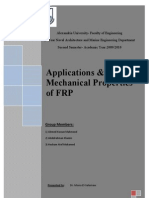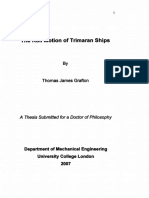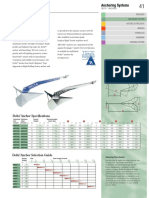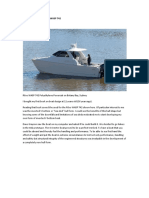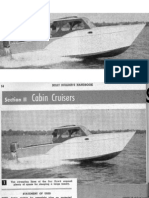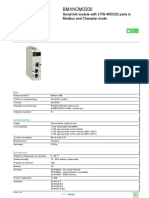Recycling of FRP Boats
Recycling of FRP Boats
Uploaded by
jayaramsomarajan1975Copyright:
Available Formats
Recycling of FRP Boats
Recycling of FRP Boats
Uploaded by
jayaramsomarajan1975Copyright
Available Formats
Share this document
Did you find this document useful?
Is this content inappropriate?
Copyright:
Available Formats
Recycling of FRP Boats
Recycling of FRP Boats
Uploaded by
jayaramsomarajan1975Copyright:
Available Formats
International Journal of Advanced Research in Engineering and Technology (IJARET)
Volume 9, Issue 3, May - June 2018, pp. 244–252, Article ID: IJARET_09_03_030
Available online at http://www.iaeme.com/IJARET/issues.asp?JType=IJARET&VType=9&IType=3
ISSN Print: 0976-6480 and ISSN Online: 0976-6499
© IAEME Publication
RECYCLING OF FRP BOATS
Jayaram S., Sivaprasad K. and Nandakumar C. G
Department of Ship Technology,
Cochin University of Science and Technology, Kochi, Kerala, India
ABSTRACT
Application of Fibre Reinforced Plastic (FRP) for marine structures range from
small boats to ships. Their scope also extends to underwater vehicles and the deck
structures of offshore platforms. Use of composites in boat building can be traced back
to nineteen fifties. Sea going boats are subjected to considerable wave forces besides
cargo loads. With the latest developments in material science, it is possible to engineer
the composite materials with necessary strength and durability in the marine
environment. Recycling of obsolete boats is a growing issue in the marine industry
especially with the interference of various environmental monitoring agencies and
maritime organisations. Recycling of the existing boats is complex and costly since the
existing boats are not ‘built to be recycled’. Besides reporting the application of non-
metallic composite in the marine environment, this paper addresses the issue of
recycling of FRP boats. A guidance plan for the recycling of FRP boats is presented in
the paper. The paper also describes the application of design for ship recycling concept
in the context of FRP boats and presents a recyclability analysis of the FRP materials
that are dismantled from the boats. Safe recycling of FRP and other materials from
boats from a sustainable development perspective has been addressed.
Key words: FRP boats, FRP Boat Recycling, Boat Recycling Plan, Design for Ship
Recycling, Recyclability.
Cite this Article: Recycling of FRP Boats, Jayaram S, Sivaprasad K. and Nandakumar
C. G. International Journal of Advanced Research in Engineering and Technology,
9(3), 2018, pp 244–252.
http://www.iaeme.com/IJARET/issues.asp?JType=IJARET&VType=9&IType=3
1. INTRODUCTION
Naval architects and boat designers have been focussing on optimisation of scantlings of hull
structure and other components in order to make boatbuilding more economical. Research
investigations to formulate boat design solutions characterised by weight reduction have not
only fetched light scantling based structural design but also robust boatbuilding materials with
high strength to weight ratio. Finite Element Analysis based structural analysis is in the former
category of the design solutions whereas the use of composite materials, such as fibre reinforced
plastic (FRP), constitutes the latter solution part.
FRP is a composite material that is composed of reinforcing fibres and a polymer matrix to
bind together the fibres. The polymer matrix is applied as a liquid resin and is chemically cured
http://www.iaeme.com/IJARET/index.asp 244 editor@iaeme.com
Jayaram S, Sivaprasad K. and Nandakumar C. G
to form a solid. Constituent materials which are commonly used as reinforcements and matrix
in FRP products used for marine structures [1] are presented in Table 1.
Table 1 Constituents of FRP used for marine structures
Reinforcing fibre Polymer matrix
Glass fibre Polyester resin
Carbon fibre Vinyl ester resin
Aramid fibre Epoxy resin
FRP is the main type of composite material which is extensively used in boat building.
Apart from the main structural advantage of high strength to weight ratio of the composite
material, some physical and manufacturing characteristics make application of FRP in ship and
boat building more suitable. These characteristics are given in Table 2.
Application of FRP in ship and boat building will become more wide spread as the identified
marine fields are being developed in a faster rate in the recent years. More number of boats
fully fitted with FRP hull and boats with extensive FRP outfits will be introduced as a result of
these developmental activities in the maritime field.
Fibre reinforced composite materials are relatively younger member in the group of
boatbuilding materials. Considering a life expectancy of about 50 years [2] for the FRP boats,
a large number of such boats that were built in 1960s and 1970s have reached the end of their
useful lives. In addition, there can be extra ordinary situations like heavy damage to boat
demanding dismantling of the hull. These situations call for efficient methodologies of
recycling of these boats in an environmentally friendly fashion and at the same time in an
economic way. However, the existing boats were designed without considerable thoughts on
their end of life in mind. In addition, the boat recycling is yet to be developed into a full-fledged
and regulated industry like the boatbuilding or boat repair. ‘Hong Kong International
Convention for the Safe and Environmentally Sound Recycling of Ships, 2009,’ which is yet to
enter into force, has laid down the regulations applicable to recycling of ships and ship recycling
facilities [3]. Hong Kong Convention is not applicable to ships of less than 500 gross tonnage.
Since a large number of FRP boats will have a gross tonnage of less than 500, the Convention
is not going not be applicable to them. Regulations governing recycling of such boats are yet to
be formulated in most of the countries.
http://www.iaeme.com/IJARET/index.asp 245 editor@iaeme.com
Recycling of FRP Boats
Table 2 Areas of application of FRP for marine structures
Material/Manufacturing Area of
Type of marine structure
Features Application
Easy manufacturing techniques, Passenger Passenger ferries
flexibility of geometry & shape, transport Country boats in inland waterways
durability, and corrosion
Luxury cruisers
resistance Recreational/ Speed launches
Tourism
House boats/Floating hotels/Cottages
Pedal boats
Deck structures of platforms
Submersibles
Offshore
Drilling and production risers
Submarine pipelines
Fishing Fishing vessels
Components of submarines and
Defence
warships
Safety
Rescue boats and life boats
equipment
General Pontoons/ Buoys/ Buoyancy drums
service Dredging pipe lines
High strength to weight ratio Superstructure & other structures
Commercial above deck
ships
Foundations and outfitting
Defence Foundations and outfitting
Non-magnetic Defence Mine sweepers
International Council of Marine Industry Associations (ICOMIA) has reported on the
history and the present situation of decommissioning of end of life boats and has summarised
on the outcome of four projects on recycling of boats [2]. In the case of recycling of naval
vessels, some research studies have already been carried out and the recycling plans have been
published [4]. The research paper has described the practical ways of recycling of glass
reinforced polyester (GRP) hull waste that is obtained from dismantling of naval vessels owned
by the Polish navy. Hedlund-Astrom et al. [5] in their paper have given the systematic and
scientific methods to recycle waste from FRP sandwich composite ship following the principle
of waste management hierarchy in recycling. Kostopoulos et al. [6] have dealt in detail with
chemical processes employed to convert waste FRP products from the dismantling yard to
useful recycled products. Hedlund-Astrom et al. [7] have proposed an efficient information
system for identification of various recycling approaches for recycling of ships having FRP hull
and usual outfitting elements consisting of different metallic parts.
Monso [8] has made an analysis of the life cycle of boats, the impact on marine environment
when they reach their end of life, and the economic aspects of boat recycling and has made
recommendations on the administrative measures necessary for managing out-of-use boats and
on the functioning of boat recycling centres. Monso [9] has presented good practices for
scrapping and management of out of use boats and their waste. Eklund et al. have described the
challenges of disposal of obsolete boats in Denmark, Norway, Finland, and Sweden, its
environmental impacts, and the present practices of reuse and recycling of materials from end
of life boats [10].
http://www.iaeme.com/IJARET/index.asp 246 editor@iaeme.com
Jayaram S, Sivaprasad K. and Nandakumar C. G
The objectives of this paper are to examine the issues in recycling of FRP boats, to propose
a general recycling plan for FRP boats, to describe the application of ‘design for ship recycling’
concept to FRP boats, and to conduct a recyclability analysis for the FRP content of the boats.
2. RECYCLING OF BOATS MADE OF FRP
2.1. Recycling of Metallic Hull versus Recycling of FRP Hull
One of the main advantages of recycling of metallic hull is that almost all metallic materials
used on ship hull can be effectively recycled by melting and re-rolling. Re-rolling of hull steel
obtained from dismantling of obsolete vessels opens up various options as far as recyclability
of dismantled products are concerned. At present, there exists no economic option like this in
the case of recycling of FRP materials, made using thermoset resins, which are used for hull of
ships and boats. Such composite hull parts cannot be converted into other useful physical forms
either by melting, rolling or thermal forming, and moulding.
2.2. Recycling Options for FRP Boats
Recycling or reuse options are generally the requirements for an effective waste management
planning in recycling of boats. The economic factors such as cost of dismantling or recycling
and the regulatory requirements influence the decision on the recyclability options. The
hierarchy for waste management plans in the boat recycling industry are well defined [2] and
have the following four major options:
• Reuse: Extending the life of a boat or its components by putting them back to use.
• Recycling: Separating components and products from the dismantled lot, reprocessing or
refurbishing the selected group of products, and then putting to use.
• Energy Recovery: Incinerating the waste material obtained from dismantling a boat to
generate energy.
• Disposal: Disposal of waste items which cannot be subjected to any of the three options
mentioned above, to a disposal or landfill site.
Unlike metallic hull structures, which have a limited span of operational life even with
application of effective hull protection mechanisms, composite hull survive much longer period
at sea. In this context it may be noted that in many occasions it will be the equipment, outfit
items, and other metallic structural components that may become obsolete much earlier than
the composite hull structure because of the exposure to marine environment and the extent of
usage. Extension of life of the main hull structure may be possible with a bit of conversion and
repair operations. This possibility gives rise to scope for direct reuse of end of life of the boat
for the function for which the hull had been designed and developed. If the quality of composite
hull is beyond scope of repair and conversion, and of reuse in the ‘as is’ condition, the hull may
be recycled and put into some other forms.
2.3. Recycling guidance plan for FRP Boats
A flow chart representing the recycling guidance plan for FRP boats has been developed and is
presented in Fig.1. The recycling of boats has been divided into four phases as shown in the
flow chart. Preparation of the boat and the dismantling of easily removable items are covered
in the first phase. It is recommended to generate a boat recycling plan, which specifies the
processes and sub-processes to be carried out along with the sequence, prior to commencement
of the recycling operations. Dismantling of main machinery, other equipment, appendages, and
outfitting items are included in Phase-2. Phase-3 consists of disassembling of hull into smaller
elements called as disassemblies in two stages such as primary disassembling and secondary
http://www.iaeme.com/IJARET/index.asp 247 editor@iaeme.com
Recycling of FRP Boats
disassembling. Primary disassembling of the boat hull will result in larger blocks and secondary
disassembling in further smaller units. Disassembling of obsolete FRP boats is complex due to
the heavy fixtures on the hull for attaching the various structural, machinery, and outfit items.
Recycling of FRP material from both the hull and other components of the boat, sale of valuable
components to the second-hand market, and treatment of waste resulting from the recycling
process are to be carried during the last phase.
2.4. Recycling methods of FRP Materials from Boats
One of the main problems associated with recycling of FRP is the use of thermoset resins, which
results in a non-reversible curing action. Unlike thermoplastics, FRP products with thermoset
resins cannot be melted down and remoulded. The techniques which can be applied for
recycling of FRP materials on the hull and other components of the boats include [11]:
• Mechanical recycling
• Thermal recycling
• Chemical recycling
• Incineration
• Landfilling
Mechanical recycling consists of shredding of FRP material followed by mixing the
resulting material with virgin material for new construction or repair. This is a simple and
technically proven method. Thermal recycling or pyrolysis involves heating up the FRP
material in an inert atmosphere in order to recover the polymer material as oil. In chemical
recycling method, chemicals are used to dissolve the resin content of the FRP. Incineration
involves combustion of FRP for energy recovery [11-12].
Co-incineration of FRP in cement kilns is considered to be a better option than incineration
since it involves both material recovery and energy recovery and, therefore, facilitates more
effective utilisation of the FRP material. In this case, burning the resin results in energy
recovery whereas the glass fibres together with the fillers become a constituent of cement,
thereby resulting in material recovery [13]. Landfilling is the last option to be considered, if
permitted by the regulatory authorities, and shall be resorted to only when it is highly
unavoidable.
http://www.iaeme.com/IJARET/index.asp 248 editor@iaeme.com
Jayaram S, Sivaprasad K. and Nandakumar C. G
Figure 1. Recycling guidance plan for FRP boats
2.5. Environmental Impacts and Safety Risks with Recycling of FRP
Fibreglass is not a naturally degrading material and, therefore, its recycling requires special
consideration and sustainable working practices. The negative environmental impacts of
recycling of FRP boats involve those resulting from handling and transport; from pollution by
dust, gases, and noise generation; and those from various processes consuming energy.
Hazardous dust and fibres that are generated during shredding and grinding processes as well
as the toxic gases produced during the burning processes make the sustainable disposal of
fibreglass difficult.
http://www.iaeme.com/IJARET/index.asp 249 editor@iaeme.com
Recycling of FRP Boats
Mechanical recycling involves safety hazards and results in an end product of low value.
Grinding of FRP materials causes fire hazards since it becomes flammable when ground. Even
though air pollution is less in thermal recycling or pyrolysis method because of the absence of
combustion in an inert atmosphere, the surface defects which may be caused by the thermal
stresses can affect the strength of the recovered fibres. In chemical recycling method,
potentially hazardous solvents are utilised to carry out this process and the FRP materials need
to be granulated resulting in a reduction of the fibre length. The draw backs of incineration are
the resulting air pollution and the requirement for further disposal of the ash, containing fibre
content of the material, which may be a hazardous waste depending on its chemical composition
[11-12].
Recycling method to be opted for recycling of FRP boats shall be both sustainable and
economically viable. These options can be analysed by applying the design for ship recycling
[14] methodology to FRP boats.
3. APPLICATION OF DESIGN FOR SHIP RECYCLING FOR FRP
BOATS
Design for ship recycling can be considered as a set of engineering guidelines to be followed
during the entire lifecycle of a vessel in order to facilitate minimum negative impact on major
environmental and safety issues identified in marine industrial sector, especially during the end
of life recycling of the obsolete vessels [14].
Recyclability of a product or a component is its ability to be altered or adapted for reuse or
to be recycled. Most of the existing boats today are not ‘built to be recycled.’ While carrying
out the design of new boats and the selection of their construction materials, designers must
consider the present technologies of recycling of such materials as well as their recyclability
options, and must incorporate the recycling related aspects into the design. This will provide
opportunities to improve the recycling potential of the boat and reduce the costs for its
recycling. Conducting a recyclability analysis in the design stage can help the boat designer to
identify the components that can be reused or recycled at the end of life of the boat and to
eliminate potentially hazardous materials to the maximum possible extent. Recyclability
analysis consisting of various direct reuses of the obsolete FRP boats and use of the dismantled
products from the boats after effective recycling processes is given in Table 2.
Majority of the small boats are made in series as compared to ships, which are one of a kind
design. So for the smaller boats, it is proposed that the designer or builder must generate a
recycling manual, which specifies the disassembling procedures for the hull as well as other
components, design for ship recycling aspects that were considered during the design stage, and
the recyclability options of the materials or components of the hull and other parts. An efficient
knowledgebase is essential for, implementing design for ship recycling and subsequently its
application, like recyclability analysis of obsolete boats and their dismantled products. This
knowledgebase on boat recycling can be used to develop an expert system [14] which will
deliver some important end of life and partial boat recycling in terms of set of recommendations
of best practices in boat recycling. If a comprehensive knowledgebase of FRP boats can be
generated, it can be further used to develop an expert system for recycling of boats built using
FRP.
http://www.iaeme.com/IJARET/index.asp 250 editor@iaeme.com
Jayaram S, Sivaprasad K. and Nandakumar C. G
Table 2 Recyclability analysis of FRP boats
Recyclability
Type of Vessel Use
Option
Reuse existing hull , but replace or upgrade the equipment
and systems
Direct reuse Floating museums
Artificial reefs
Floating shopping complex/stores
Dismantled and cut to flat panels/flat bar stiffeners
Walls in composite boat moulds
Use pyrolysis method to extract the resin from the
composite
Ocean going vessels Grinding fibreglass into loose fibres and powdered resin
and use them to replace fibreglass in new products
Co-incineration in cement kilns for energy recovery and
Recycle to form as a constituent of cement
For noise absorption in wall panels
To manufacture artificial wood [13] or wood substitute
planks
Use along with other materials for road construction [13]
Use for fence posts, manhole covers, steps, pots for plants
Incineration for energy recovery
Reuse existing hull , but replace or upgrade the equipment
and systems
Direct reuse Floating shops
Passenger ferries Floating jetties
Floating stores
Recycle Same as that for oceangoing vessels mentioned above
Reuse existing hull , but replace or upgrade the equipment
Recreational speed boats Direct reuse
Paddle boats in lakes/ponds
Paddle boats Direct reuse Waste bins
4. DISCUSSION AND CONCLUSIONS
The necessity to carry out recycling of FRP boats that have reached the end of their useful lives
is a growing issue being faced by the global maritime community. Being a complex activity,
recycling of FRP boats are to be carried out in a systematic manner. This requires a guidance
plan that enables monitoring of the sequential processes involved in the recycling activities.
Generation of knowledgebase in the recycling of FRP boats is an important aspect to be
addressed by the maritime engineering community, especially by a group of experts consisting
of material scientists, chemical engineers, naval architects, pollution control scientists and the
maritime administrators. Application of ‘design for ship recycling’ philosophy will enable to
formulate a frame work for feasible solutions in this area. Application of expert system for
recycling of boats built using fibre reinforced composite materials can help the stake holders
http://www.iaeme.com/IJARET/index.asp 251 editor@iaeme.com
Recycling of FRP Boats
in the boat recycling industry to ensure safe and environmentally friendly recycling leading to
sustainable development in the maritime industrial domain.
Various issues related to recycling of obsolete FRP boats have been addressed in this paper.
A recycling guidance plan, which indicates various processes to done in sequential order, has
been developed and presented in the form of a flow chart. Application of the ‘design for ship
recycling’ concept to FRP boats has been described and a recyclability analysis has been
conducted for the FRP materials that form part of the hull and the other components of boats.
REFERENCES
[1] Eric Greene Associates. Marine Composites, 2nd Edition. Maryland, US: Eric Greene
Associates, 1999.
[2] ICOMIA (International Council of Marine Industry Associations). Decommissioning of End-
of-Life Boats- A Status Report, 2nd edition. London: International Council of Marine Industry
Associations, 2007.
[3] IMO (International Maritime Organisation). Hong Kong International Convention for the Safe
and Environmentally Sound Recycling of Ships, SR/CONF/45. Hong Kong: International
Maritime Organisation, 2009.
[4] Jastrzebska, M., Rutkowska, M. and Jurczak, W. Recycling of Ships Made of Glass Reinforced
Polyester. Proceedings of the International Conference on Recycling of Ships and Other Marine
Structures, London, 2005 pp. 115-119.
[5] Hedlund-Astrom, A., Luttropp, C. and Reinholdsson, P. Environmental Friendly Recycling of
FRP-Sandwich Ship Hulls. Proceedings of the International Conference Recycling of Ships and
Other Marine Structures, London, 2005 pp. 119-127.
[6] Kostopoulos, V., Fotiou, I. and Loutas, T. Review of Recycling Processes on Composite
Materials. Proceedings of the First International Conference on Dismantling of Obsolete
Vessels, Glasgow, 2006 pp. 79-85.
[7] Hedlund-Astrom, A. and Luttropp, C. Access of Hazardous and Metallic Integrated Objects at
Dismantling of Sandwich Ship Structures through Effective Information Handling. Proceedings
of the First International Conference on Dismantling of Obsolete Vessels, Glasgow, 2006 pp.
59-65.
[8] Monso, M.V. Diagnosis of the Current Situation of Out-of-Use Nautical Boats in Europe-
Exploration of Scrapping Process, Economic Study of Recovery and Proposals for Future.
[9] Monso, M.V. Guide on Good Scrapping and Waste Management Practices for Out-of-Use
Boats. 2012.
[10] Eklund, B., Haaksi, H., Syversen, F. and Eisted, R. Disposal of Plastic End-of-Life-Boats.
Copenhagen: Nordic Council of Ministers, 2013.
[11] Bartholomew, K. Fibreglass Reinforced Plastics Recycling. Minnesota Technical Assistance
Program, 2004.
[12] Fibreline Composites. Breakthrough: Recycling of Fibreglass is now a Reality, 2010.
https://fiberline.com/news/miljoe/breakthrough-recycling-fibreglass-now-reality
[13] Halliwell, S. Best Practice Guide- End of Life Options for Composite Waste. Cambridge, UK:
TWI Ltd, 2006.
[14] Sivaprasad, K. Development of Best Practices for Ship Recycling Processes. Ph.D. Dissertation,
Kochi: Cochin University of Science and Technology, 2010.
http://www.iaeme.com/IJARET/index.asp 252 editor@iaeme.com
You might also like
- RAC Questions AnswersDocument5 pagesRAC Questions AnswersJasper0% (1)
- Hydrofoil Ship Design - W NeillDocument46 pagesHydrofoil Ship Design - W NeillGölfried GeorgeNo ratings yet
- How To Dimension Sailing CatamaranDocument10 pagesHow To Dimension Sailing CatamaranFiqhy DianNo ratings yet
- Ship and Boat Building and Repair-5Document5 pagesShip and Boat Building and Repair-5navalmamunNo ratings yet
- Applications & Mechanical Properties of FRPDocument34 pagesApplications & Mechanical Properties of FRPAhmedHassen7No ratings yet
- BV Rules For The Classification and The Certification of Yachts Feb 08 Edition v1Document65 pagesBV Rules For The Classification and The Certification of Yachts Feb 08 Edition v1فضيلة عبدالرحمنNo ratings yet
- School of Maritime Studies Vels University Thalambur: Life Boat AIMDocument2 pagesSchool of Maritime Studies Vels University Thalambur: Life Boat AIMAayush AgrawalNo ratings yet
- ILUR - Plan 05 Stations Dimensions (Strip Planking Version) Scale 1/10 23 January 2004 François Vivier Architecte NavalDocument1 pageILUR - Plan 05 Stations Dimensions (Strip Planking Version) Scale 1/10 23 January 2004 François Vivier Architecte NavalGEORGE KARYDISNo ratings yet
- GRP Boat Building InstructionsDocument27 pagesGRP Boat Building InstructionsMiguel MendezNo ratings yet
- Soel YacthsDocument24 pagesSoel YacthsMaricar C. CamarilloNo ratings yet
- Roll Motion of Trimaran ShipsDocument273 pagesRoll Motion of Trimaran ShipsPhilSelborNo ratings yet
- Arrow 1500 DC Study PlansDocument20 pagesArrow 1500 DC Study PlansVitBar100% (1)
- Whisstock: Design 165 Doghouse Version Laminated Frames Longitudinal Structures Profile ViewDocument1 pageWhisstock: Design 165 Doghouse Version Laminated Frames Longitudinal Structures Profile ViewhjukNo ratings yet
- The Design RatiosDocument55 pagesThe Design RatiosAmit SharmaNo ratings yet
- Foot CatamaranDocument2 pagesFoot CatamaranАндрей КовальчукNo ratings yet
- Review of Ship Structural DetailDocument330 pagesReview of Ship Structural Detailreza84No ratings yet
- Rules Wooden Vessel PDFDocument66 pagesRules Wooden Vessel PDFLucas GuesseNo ratings yet
- Design of High Speed Planing Hulls For TDocument17 pagesDesign of High Speed Planing Hulls For TTihomir MarkovicNo ratings yet
- Hydrofoil CraftDocument9 pagesHydrofoil CraftAnonymous e3ceN15100% (1)
- ILUR - Plan 21 Rev 2 Backbone Structure Scale 1/15, 1/5 Et 1/2 27 January 2013 François Vivier Architecte NavalDocument1 pageILUR - Plan 21 Rev 2 Backbone Structure Scale 1/15, 1/5 Et 1/2 27 January 2013 François Vivier Architecte NavalGEORGE KARYDISNo ratings yet
- Ferro Cement 2Document22 pagesFerro Cement 2Abhishek DorugadeNo ratings yet
- Laminate GuideDocument3 pagesLaminate GuideYeni AgustiningsihNo ratings yet
- DNV Rules For Woodenships 1970Document146 pagesDNV Rules For Woodenships 1970Manuel Cares FuentesNo ratings yet
- Press R. Zefira: Yacht DesignDocument5 pagesPress R. Zefira: Yacht DesignZefiraNo ratings yet
- Introduction To Boat Building in CompositesDocument4 pagesIntroduction To Boat Building in CompositesMax BeeksNo ratings yet
- Stability of MultihullsDocument11 pagesStability of MultihullsnecatiygtNo ratings yet
- Intro To GRP and Hand Laid-Up GRP Moulding-PNS JAUHARDocument187 pagesIntro To GRP and Hand Laid-Up GRP Moulding-PNS JAUHARImran AhmedNo ratings yet
- Delta Anchor SizingDocument1 pageDelta Anchor SizingPhilSelborNo ratings yet
- (Catamaran) Effects of Shallow Water On Catamaran Interference CFD - Delft 372Document6 pages(Catamaran) Effects of Shallow Water On Catamaran Interference CFD - Delft 372Wm Erick CrNo ratings yet
- NirvanaDocument8 pagesNirvanaAndrei IulianNo ratings yet
- Engines For Planing BoatsDocument16 pagesEngines For Planing BoatsAlex MarcusNo ratings yet
- 07 - DNVs Hull STR For WW - Hull STR - Cargo Area - BottomDocument30 pages07 - DNVs Hull STR For WW - Hull STR - Cargo Area - BottomArpit Goyal100% (1)
- Concrete ShipsDocument112 pagesConcrete ShipsDábilla Adriana BehrendNo ratings yet
- The Development of A Hydrofoil-Supported-Rigid-Inflatable BoatDocument15 pagesThe Development of A Hydrofoil-Supported-Rigid-Inflatable BoatBoby48007No ratings yet
- Presentation On Hovercraft: Presented byDocument21 pagesPresentation On Hovercraft: Presented byNehaNo ratings yet
- A Runabout Reborn - Fast Modern Schooner - Lapstrake Primer: The Magazine For Wooden Boat Owners, Builders, and DesignersDocument152 pagesA Runabout Reborn - Fast Modern Schooner - Lapstrake Primer: The Magazine For Wooden Boat Owners, Builders, and DesignersPablo Besser100% (1)
- Choosing HullDocument16 pagesChoosing Hullnyaungzin100% (1)
- How To Fiberglass BoatsDocument123 pagesHow To Fiberglass BoatsMaxi Sie100% (1)
- Devlopment of The Rêvo Wasp 743 PDFDocument14 pagesDevlopment of The Rêvo Wasp 743 PDFrobertoNo ratings yet
- Sailing Hydrofoils - A.Y.R.S. Publication No.74, 1970Document292 pagesSailing Hydrofoils - A.Y.R.S. Publication No.74, 1970VitBarNo ratings yet
- Sea HawkDocument19 pagesSea HawkAlphamatrix01100% (2)
- Ship BuildingDocument29 pagesShip Buildingtmtt44No ratings yet
- DuFlex, Lightweight Composite PanelsDocument16 pagesDuFlex, Lightweight Composite PanelsDennys RamirezNo ratings yet
- Resistance Components of A CatamaranDocument13 pagesResistance Components of A CatamaranSciencezNo ratings yet
- BG Yacht Design - Pantanal 25Document6 pagesBG Yacht Design - Pantanal 25Lord AlmightyNo ratings yet
- Rhino 590 Specifications Jan 06-1Document6 pagesRhino 590 Specifications Jan 06-1MohdFarid100% (1)
- Yacht Design ENGDocument4 pagesYacht Design ENGArchin TactNo ratings yet
- Tore Holm - Bronze Fastenings - Butterfly Skylight: The Magazine For Wooden Boat Owners, Builders, and DesignersDocument140 pagesTore Holm - Bronze Fastenings - Butterfly Skylight: The Magazine For Wooden Boat Owners, Builders, and DesignersPablo BesserNo ratings yet
- GroupD ManualDocument24 pagesGroupD ManualTerminal VelocityNo ratings yet
- WBTA - Tunnel SternsDocument4 pagesWBTA - Tunnel SternsGermán Cristian Camacho SilvaNo ratings yet
- EN ISO 12215-1 - Small Craft - Hull Construction and ScantlingsDocument17 pagesEN ISO 12215-1 - Small Craft - Hull Construction and Scantlingsalessandro cabrasNo ratings yet
- 60M Mondo Marine 2014Document4 pages60M Mondo Marine 2014Denison Yacht SalesNo ratings yet
- Boat Design GlossaryDocument10 pagesBoat Design GlossaryTarek MohamedNo ratings yet
- Design 2005Document21 pagesDesign 2005bugsy77No ratings yet
- Applications of Composites in Marine Industry: Dr. S. Selvaraju, S.IlaiyavelDocument3 pagesApplications of Composites in Marine Industry: Dr. S. Selvaraju, S.IlaiyavelabhiNo ratings yet
- Sample Paper 3 PDFDocument28 pagesSample Paper 3 PDFAnni MataqeiNo ratings yet
- ClassNotes MC&W 1Document53 pagesClassNotes MC&W 1Soorsri T SNo ratings yet
- Composite in Marine ApplicationsDocument12 pagesComposite in Marine ApplicationsJithin Devan PadincharayilNo ratings yet
- 15 A Application of Composite MaterialsDocument3 pages15 A Application of Composite MaterialsKazi Tour DépenseNo ratings yet
- 2020.05 JKOSOMES TestandEvaluationProcedureofFoamCoreMaterialsforCompositeShipsDocument12 pages2020.05 JKOSOMES TestandEvaluationProcedureofFoamCoreMaterialsforCompositeShipsPrudhvi GogineniNo ratings yet
- CaseDocument2 pagesCasegkrehman0% (1)
- Ovwmp IGC0 LXF SVYubzo EDocument6 pagesOvwmp IGC0 LXF SVYubzo ESamarth KhatorNo ratings yet
- SSRN Id2395277Document3 pagesSSRN Id2395277ken nguyenNo ratings yet
- Aakash Vishwakarma (PG Thesis)Document75 pagesAakash Vishwakarma (PG Thesis)Akrity ParasharNo ratings yet
- Programmers GuideDocument76 pagesProgrammers GuideLy TheDanNo ratings yet
- Virtual and Augmented Reality ECC4351Document63 pagesVirtual and Augmented Reality ECC4351KeertanaNo ratings yet
- BMXNOM0200-Serial Link Module With 2 RS-485232 Ports inDocument3 pagesBMXNOM0200-Serial Link Module With 2 RS-485232 Ports ingrtabhilkwNo ratings yet
- Zimbabwe Energy PolicyDocument70 pagesZimbabwe Energy PolicyEd Chikuni50% (2)
- Mozilla Public License 2.0Document15 pagesMozilla Public License 2.0Sydney D. BajentingNo ratings yet
- Late in The Day at An Antique Rug Auction ThereDocument1 pageLate in The Day at An Antique Rug Auction Theretrilocksp SinghNo ratings yet
- Revalidation FormatDocument2 pagesRevalidation FormatVipin KumarNo ratings yet
- Maersk - New BOQDocument22 pagesMaersk - New BOQMT JasonNo ratings yet
- Mathematics Paper 2 Q CEKENAS Mocks 2023Document21 pagesMathematics Paper 2 Q CEKENAS Mocks 2023kongoemmanuel2006No ratings yet
- 18 Supreme Court Reports Annotated: Cabigas Us. PeopleDocument10 pages18 Supreme Court Reports Annotated: Cabigas Us. PeopledelayinggratificationNo ratings yet
- Circulation PatternDocument7 pagesCirculation PatternPrince PhilipNo ratings yet
- COPPUS Steam Turbines PRODUCT GUIDEDocument6 pagesCOPPUS Steam Turbines PRODUCT GUIDEaminardakaniNo ratings yet
- Edited Flipped ClassroomDocument58 pagesEdited Flipped ClassroomJonathan Agcaoili KupahuNo ratings yet
- Agile in Enterprise Resource Planning A Myth No MoreDocument8 pagesAgile in Enterprise Resource Planning A Myth No Moreprbansal100% (1)
- Catalogue of Fog Misting SystemDocument18 pagesCatalogue of Fog Misting SystemwapanchoNo ratings yet
- Application Eori Headquartered Inside Netherlands Do4391z9folengDocument2 pagesApplication Eori Headquartered Inside Netherlands Do4391z9folengIvan Da Silva BrazNo ratings yet
- Cost Accounting Worksheet Chap 3Document5 pagesCost Accounting Worksheet Chap 3Muhammad UsmanNo ratings yet
- Wopq Format Asme Qw-360Document1 pageWopq Format Asme Qw-360Anonymous S33n8gNo ratings yet
- SIMATICPCS7 STPCS7AO Complete English 2013 WebDocument180 pagesSIMATICPCS7 STPCS7AO Complete English 2013 WebDiana ArredondoNo ratings yet
- Roots BlowerDocument7 pagesRoots BlowerRyad GuiraNo ratings yet
- WCT-06 FeeSched Rev18Document1 pageWCT-06 FeeSched Rev18sami NaNo ratings yet
- Full Paper No 43 M 2Document9 pagesFull Paper No 43 M 2Anonymous 8qUHG4SlNo ratings yet
- Krohne Marshall Product OverviewDocument56 pagesKrohne Marshall Product Overviewzakir84md3639No ratings yet
- Perancangan Kapal Bulk Carrier 9.000 DWT Kecepatan 12 Knot Dengan Rute Pelabuhan Yos Sudarso - Pelabuhan Soekarno-HattaDocument21 pagesPerancangan Kapal Bulk Carrier 9.000 DWT Kecepatan 12 Knot Dengan Rute Pelabuhan Yos Sudarso - Pelabuhan Soekarno-HattaasrunNo ratings yet
- Traversing (NICE)Document33 pagesTraversing (NICE)prasitagnihotriNo ratings yet




